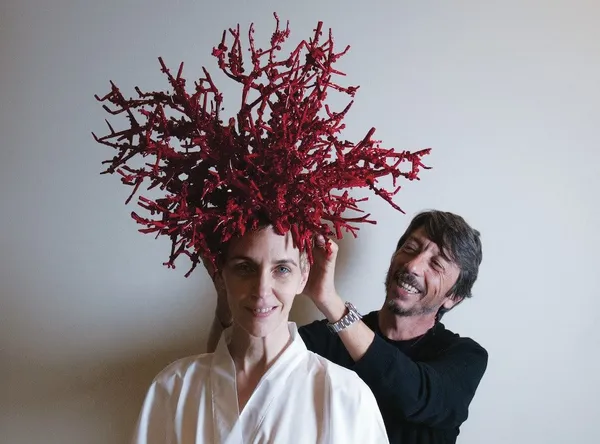 |
| Backstage at the Valentino Haute Couture Spring 2020 collection with Hannelore Knuts and creative director Pierpaolo Piccioli Photo: Archivio Fotografico Paolo Di Paolo |
Pier Paolo Pasolini, Luchino Visconti, Anna Magnani, Michelangelo Antonioni, Elizabeth Taylor, Richard Burton, Charlotte Rampling, Grace Kelly, Marcello Mastroianni, Rudolf Nureyev, Sophia Loren, Ezra Pound, Faye Dunaway, Monica Vitti, Giorgio de Chirico, Gina Lollobrigida, Tennessee Williams, Marlene Dietrich, Giulietta Masina, Simone Signoret, Yves Montand, Brigitte Bardot, Catherine Deneuve, Anita Ekberg, Vittorio De Sica, Alberto Moravia, and many others were photographed by Bruce Weber’s muse and subject of his latest documentary The Treasure Of His Youth: The Photographs Of Paolo Di Paolo, which starts with an overture of images and film clips. After putting his camera away for decades we see di Paolo return to shoot Pierpaolo Piccioli’s Valentino Haute Couture Spring 2020 collection.
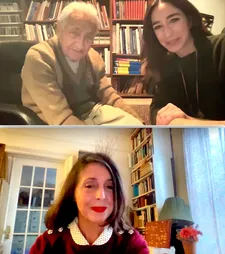 |
| Paolo di Paolo with Silvia di Paolo and Anne-Katrin Titze on Tennessee Williams: “I first met him when he was with Anna Magnani because they were shooting The Rose Tattoo.” |
Paolo di Paolo’s photographs are a revelation and Bruce Weber does not hide his amazement about discovering them. The director, excellent at feel and mood - think of his Chet Baker film, Let’s Get Lost, or his Ralph Lauren print ads embracing the millennium - adds vital clips to the still images. A festival in di Paolo’s hometown of Larino, Italy, is juxtaposed with a quote by Nan Goldin how the attempt to preserve in photography turns into the realisation of how much is lost. In an intertitle we read: “I used to think that I could never lose anyone if I photographed them enough. In fact, my pictures show me how much I have lost.” Lost, clearly being a pivotal word for Weber, in itself holds the pull to fight it, as the dream of resurrection always floats along with it.
On June 12 1949, Paolo left his hometown. Fascism had coloured his youth. He expresses regret of not knowing about Ernest Hemingway, George Orwell, or Thomas Mann earlier. Or any painters for that matter. Weber’s choice of clips from Roberto Rossellini’s Rome, Open City from 1945 will never lose their sting. They are perfect and life-affirming. “Spring will come and more beautiful than ever before,” reminds us of the most profound sentiment - how good it is to be alive.
Paolo di Paolo studied philosophy and the pictures add to his quest for understanding something about humanity. We also learn that he chronicled the history of the Carabinieri, and gave up photography altogether when the world of magazine publishing started to change. His daughter Silvia found at one point boxes of negatives that revealed a past of her father she knew nothing about.
Di Paolo’s photos were published in Il Mondo and Omnibus in the Fifties and Sixties. At that point, photos did not illustrate the text. They were telling their own story that was in dialogue with the written word. Women in the realm of Italian agriculture make you think of August Sander images. A sick child in rags, one of the most remarkable images in the entire film, makes you think of all the unnecessary wounds inflicted on the innocent, a defencelessness crying out, and a dignity beyond measure.
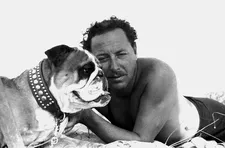 |
| Tennessee Williams with one of his bulldogs, Tor San Lorenzo beach (Rome), 1955 Photo: Archivio Fotografico Paolo Di Paolo |
Forte dei Marmi, where in the 1920s and 30s Aldous Huxley would come to write, where “Thomas Mann made his sons bathe nude” and where Rainer Maria Rilke created his poetry is discussed in Pasolini’s article The Long Road of Sand. Bernardo Bertolucci as a teenager felt when Pasolini came by to talk to his father, that Pasolini’s gaze “robbed you of something.” In a fascinating stream of consciousness Weber continues on to Anna Magnani at home and the trust she felt for the unknown handsome photographer (di Paolo) who managed to get her essence without makeup, in a simple bathing suit and a weary, expectant, glorious smile.
“Was there ever a woman you photographed that took your breath away?” We hear Bruce Weber ask in voiceover, as we see Simone Signoret with Yves Montand. Then Bardot, Loren, Deneuve, Rampling, Ekberg. “Every time,” is Paolo di Paolo’s diplomatic response.
In 2019 the gallery exhibition Paolo di Paolo Mondo Perduto - Fotografie 1954-1968 in Rome at Spazio Extra MAXXI, in collaboration with Gucci, brought the titular Lost World back to public awareness as a shimmer of what seems like a glamorous mid-century past, while at the same time exposing the hardships.
The man, who as a baby was saved by “wine baths” emerges like a phoenix to resurrect with his photographs for us the beauty and the suffering, the thoughtfulness and the distractions of what it meant to be alive in the 20th century. Bruce Weber’s unerring sense of style, hovering around the abyss, makes this film a feast of discovery.
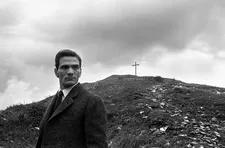 |
| Pier Paolo Pasolini at the Monte dei Cocci, Rome (1960) Photo: Archivio Fotografico Paolo Di Paolo |
From Rome, Paolo di Paolo, 97 years young, joined me on Zoom with his daughter Silvia di Paolo as our translator for an in-depth conversation on The Treasure of His Youth: The Photographs of Paolo Di Paolo and his fascinating life.
Anne-Katrin Titze: Very nice to meet you both, Paolo and Silvia! Beautiful film, beautiful photography! Let’s maybe start with how this film came about. How did Bruce Weber contact you at first? Were you hesitant to return to the past? Tell me how the film began!
Paolo di Paolo: When Bruce first contacted me, I said I’m like the Greta Garbo of photography!
AKT: That’s beautiful!
PdP: Of course talking about my own beauty.
AKT: And style!
PdP: And how tall I am! When Bruce started and wanted to do this film in the beginning I didn’t believe it, because it was like a joke. Actually when Bruce first started shooting it wasn’t supposed to be a film. He just wanted to make a record to know some more facts for the family. But in the end it came out an almost two hour-long film. For them it was quite hard to edit because the footage was so much more material.
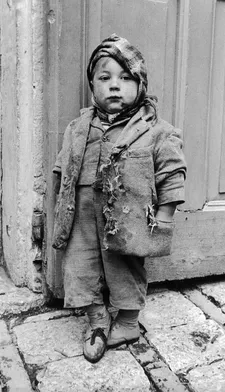 |
| Child of Forchia (Benevento), 1959 Photo: Archivio Fotografico Paolo Di Paolo |
AKT: It’s fascinating to see all the people you photographed. Some are more the focus of the film, for instance Pasolini or Anna Magnani. I am curious about Tennessee Williams. Do you have any memories about the shoot with him?
PdP: I first met him when he was with Anna Magnani because they were shooting The Rose Tattoo [directed by Daniel Mann in 1955]. We spent an afternoon together with Anna Magnani and him. He was very smart, intelligent and sensitive and he probably felt my attitude. So we spent the following day together. We went to the sea, to a free beach. He was with his dog and we spent a beautiful day together.
We went to the beach in separate cars and Tennessee Williams was with his dog and very relaxed and feeling very confident with me. I took these beautiful pictures of him at the beach in a very funny swimsuit, like Twenties style. He was very spontaneous. I had a very nice lunch at the beach with him. I also want to tell you about another great American writer, Ezra Pound.
AKT: Yes, please tell me about Ezra Pound!
PdP: With Tennessee Williams, we immediately clicked. Some relationship happened immediately. I think I captured his real essence with just a few shots because we felt we were near. When I met Ezra Pound I was in Spoleto. There is this theater festival they have in Umbria. He was with this journalist who said “He’s waiting for you.” And I said he cannot be waiting for me. Because during that time, Ezra Pound didn’t talk to people. In his last years he was not talking.
So I knocked at the door. Nobody answered. Then I opened the door and he was standing in the middle of the room like a statue. And that’s how I really hoped to find him. As a statue. And I portrayed him like this.
AKT: Well, he is!
PdP: I said good morning but he didn’t even reply because he was not talking. So I understood what I had to capture and that was his silence. I was going around taking pictures of him and that’s it. He was posing like this. He wanted this. He wanted his silence captured.
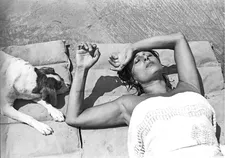 |
| Anna Magnani with her dog in her villa in San Felice Circeo, Italy (1955) Photo: Archivio Fotografico Paolo Di Paolo |
AKT: I am torn right now. Two questions are fighting with each other. One of them is about your experiences photographing beauties like Charlotte Rampling and Faye Dunaway. The other is about a moment that is so touching and so much at the core of the film - the photographing of the injured child in rags. I leave it to you which one to address first.
PdP: With these beautiful women I was trying to capture something that was beyond the physical aspect. And I think I did it often, not only with beautiful actresses and women of cinema but also with this politician who was a very tough, not beautiful woman. So on the other hand I captured the soft part of the personality. My mission was to go beyond the skin of the person, beyond the surface and to capture the most intimate part.
AKT: In a way that answers both my questions, because with the boy in rags, you really capture the beauty and the pride and the dignity of the child.
PdP: Thank you.
AKT: You say something about how the child couldn’t defend himself from the camera. Late in the film there is a clip of Bernardo Bertolucci talking about Pasolini’s gaze. And how he felt Pasolini’s gaze was somehow robbing people of something. Was there ever the feeling of someone’s gaze robbing you of something?
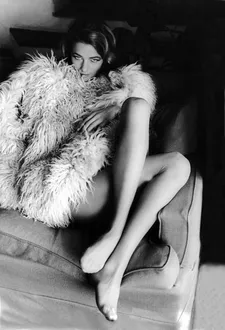 |
| Charlotte Rampling on the Sardinia set of Gianfranco Mingozzi’s Sequestro Di Persona (1966) Photo: Archivio Fotografico Paolo Di Paolo |
PdP: You mean if I felt I was stealing something from someone I portrayed?
AKT: Either that or the opposite, that the person you were photographing stole something of you.
PdP: I and another little group of photographers in the early Fifties, we kind of invented photography, because before that there was no photography. We were doing it with a lot of modesty and were almost unknown. The day I put my camera back in a shoebox, for me it was a very respectful and important sign to photography.
In Italy there was never a photographic movement that was serious and important, that was able to communicate and to touch, going beyond the image. To go back to the question of stealing - there is a portrait I took of a poet who is very famous in Italy, called Vincenzo Cardarelli. He was always in the middle of the street with people in Via Veneto because he was afraid of death. I do feel I stole this feeling of being afraid of death taking a photo of him.
AKT: That is a fantastic answer, thank you! With your photos I feel so often that they go far outside preconceived notions, boxes. For example, the photographs of the society debut ball you compare to a safari. It is often in the photographs that two things people wouldn’t put together are put together by you. So often two worlds are combined.
PdP: You are very good because you got the point of my photography! In fact I was able to portray the same way Raquel Welch and other beautiful women and at the same time I spent four months in the prisons doing a reportage about criminals. The worst assassins and criminals in Italy. My eye was so free from preconceived notions. I consider one of my best reportages this one about the prisoners.
AKT: Let’s jump from there to the [2020] Valentino Couture show in Paris. How was it going back to photography?
PdP: It was pure fun! I did it because I felt friendship with Pierpaolo Piccioli. He’s a very special person and I felt very close to him. That’s why I accepted to do it. For fun. In fact, we had a great time.
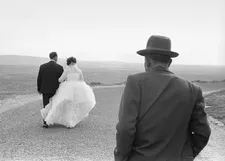 |
| Country wedding with the father of the bride Photo: Archivio Fotografico Paolo Di Paolo |
AKT: Bruce Weber says at the end that as a photographer you find out through the photographs the mystery of yourself. Is this something you can relate to?
PdP: The dis-known. There was something more. Looking back and also answering to the question why I quit photography - thanks to photography I understood who I am. Probably my philosophical studies that I did before being a photographer were what helped me to do what I did.
Looking at my photographs afterwards, I recognised my philosophical studies and how my state of mind was. It’s very interesting when I see the contact sheets in the archive. In each row there are two shots for each situation. I don’t know if you saw in the film the family looking at the sea. It was one shot and I knew what was going to happen in my mind and it happened. So today when I see my photographs I recognise its mental structure.
AKT: When you studied philosophy, who inspired you the most?
PdP: Of course I studied all, because I was studying the history of philosophy. But when I had a fight with Kant, the father of Enlightenment, something happened. Kant is considered a giant but I had this crash with his work. I thought he was totally wrong.
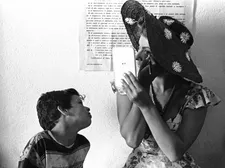 |
| Sophia Loren on the set of Michael Curtiz’s A Breath Of Scandal in Sorrento Photo: Archivio Fotografico Paolo Di Paolo |
AKT: Wow, how so?
PdP: I had a discussion with my teacher. To write my Master’s thesis it took me eight years. 700 pages, eight years. After these 700 pages, I wrote a little text which was the synthesis of the 700 pages, the introduction of what I wrote. This very little book was much easier to understand. I thought that Kant himself was not convinced about his work.
AKT: I see I was opening a can of worms here! I love talking about Immanuel Kant in the same context as Gina Lollobrigida! Thank you!
PdP: You’re a pretty lady!
AKT: Thank you very much.
PdP: Thank you very much for your time!
The Treasure Of His Youth: The Photographs Of Paolo Di Paolo will open at Film Forum in New York on Friday, December 9.





















